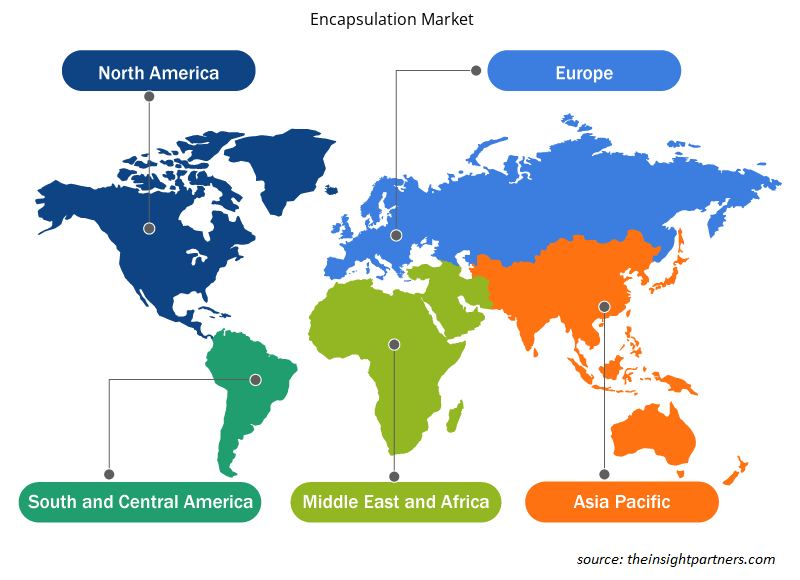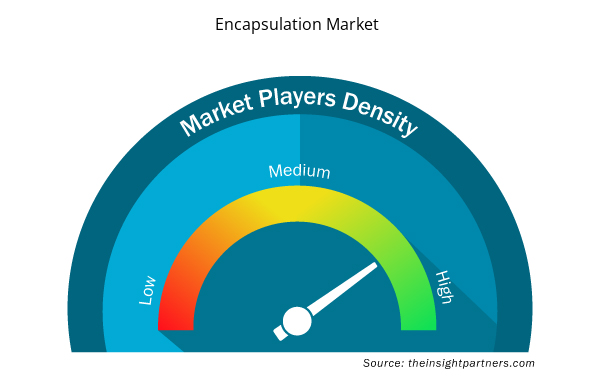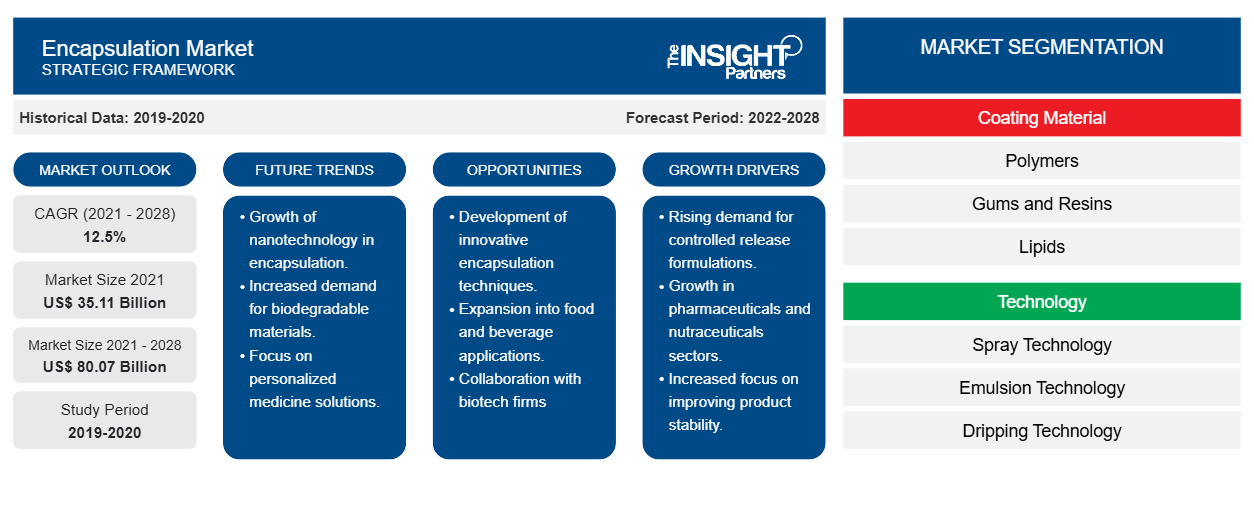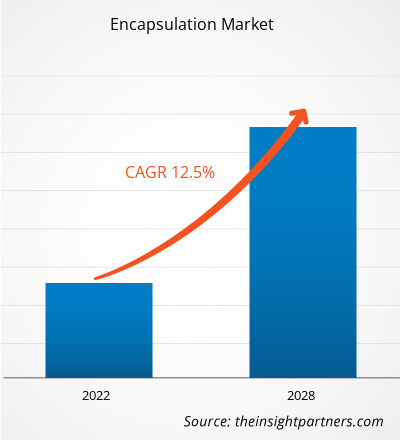封装市场预计将从 2021 年的 351.1349 亿美元增长到 2028 年的 800.7165 亿美元;预计 2021 年至 2028 年的复合年增长率为 12.5%。
由于方便食品行业对封装香料和色素的需求不断增长,对封装的需求也显著增加。世界各地个人快节奏的生活方式变化以及全球城市人口的增长推动了对方便食品的需求。由于疾病负担加重、医疗保健系统的改善和可支配收入的增加,对封装药品的需求正在上升,这也推动了市场的增长。
预计亚太地区的封装市场在预测期内将以最高的复合年增长率增长。许多亚太国家,例如中国和印度,是世界上人口增长最快的国家之一。食品行业由于其广泛的应用范围而正在该地区扩张。中国、印度、日本和韩国存在各种成熟的行业,例如食品和饮料,这增加了该地区对包装解决方案的需求。年轻人对膳食补充剂的高需求推动了封装市场的发展。膳食补充剂的主要成分,如维生素和酶,需要有针对性的输送。健康意识、营养和福祉等一些流行因素正在推动消费者对支持更长寿和更健康生活的食品的行为。民众对功能性食品和膳食补充剂的需求正在增加。因此,随着该地区包装食品和饮料消费量的不断增长,预计亚太地区的封装市场在预测期内将出现显着增长。
定制此报告以满足您的需求
您可以免费定制任何报告,包括本报告的部分内容、国家级分析、Excel 数据包,以及为初创企业和大学提供优惠和折扣
- 获取此报告的关键市场趋势。这个免费样品将包括数据分析,从市场趋势到估计和预测。
COVID-19 疫情对封装市场的影响
随着 COVID-19 疫情在全球爆发,大多数国家宣布进入卫生紧急状态并停止了不必要的活动。这场危机严重影响了商品供应链。在危机中,消费者对健康食品和饮料的需求激增,以增强免疫力。由于制造部门关闭、原材料价格上涨、劳动力短缺、供应链中断和金融不稳定,COVID-19 疫情对全球封装市场产生了负面影响。此外,各国政府正计划开发现代化和技术先进的基础设施,以减轻 COVID-19 疫情对经济的影响。因此,它有助于促进建筑业的发展,这将在未来几年推动对封装的需求。预计此次疫情将对市场产生较小影响。然而,随着控制病毒传播的规范的放宽,市场在采取必要预防措施的情况下恢复了。
市场洞察
方便食品行业对胶囊香精和色素的需求不断增长
封装可以提供功能特性,例如在预定环境中控制释放。封装调味料在方便食品领域被广泛用于控制食品中调味料和色素的释放,包括茶包、糖果、速溶饮料和甜点。全球个人快节奏的生活方式变化和全球城市人口的增长推动了对方便食品的需求。方便食品行业包括旨在减少最终用户准备时间的食品。过去十年,全球方便食品行业的需求大幅增加,预计在预测期内将大幅增加。
涂层材料洞察
根据包衣材料,封装市场细分为聚合物、树胶和树脂、脂质、碳水化合物和蛋白质。碳水化合物部分在 2020 年占据了最大的市场份额,而聚合物部分预计在预测期内将在市场上实现最高的复合年增长率。碳水化合物是用于调味剂封装的首要聚合物,因为它们具有良好的物理化学性质、良好的水溶性、低粘度以及对挥发性有机化合物的优异阻隔性。碳水化合物的包衣材料包括淀粉、麦芽糊精、壳聚糖、玉米糖浆固体、葡聚糖、改性淀粉、果糖和环糊精。聚合物封装在制药行业中用于口服药物,并掩盖味道和气味,以提高患者的依从性并减少胃肠道刺激和毒性。
技术洞察
根据技术,封装市场细分为喷雾技术、乳化技术、滴注技术等。喷雾技术部分在 2020 年占据了最大的市场份额。喷雾技术涉及在热空气中喷洒水溶液,从而提供更高的效率。食品工业中,通过喷雾技术开发颗粒的最推荐载体是醇、脂肪酸、三酰甘油和蜡。乳化技术将敏感物质(例如矿物质和维生素)包埋在载体或涂层材料中,然后再添加到食品中。因此,它使营养素非常稳定并易于分散在介质中。因此,方便食品行业对封装风味和食品的需求激增,正在推动全球封装市场的增长。
应用程序洞察
根据应用,封装市场细分为药品和营养品、食品和饮料、个人护理产品、农用化学品等。由于大量公司使用封装来掩盖药物的苦味或气味并提供有针对性和可控的递送,预计未来几年药品和营养品领域的市场将增长。由于制造商获得了好处,制药行业也受到封装技术的极大影响。食品封装可以保留风味并去除异味。消费者对健康和方便食品的偏好日益增加、对包装食品的需求不断增长、生活方式的改变以及对即食食品的偏好预计将在预测期内推动全球市场增长。
封装市场中的少数参与者包括 Encapsys, LLC;Lycored;Tastetech;Givadan;Balchem, INC;FrieslandCampina;DSM;Microtek Laborotories, INC;Legris Industries Group;和 BASF SE。主要公司采用并购和研发等策略来扩大客户群并在全球市场中获得显著份额,这也使他们能够在全球范围内保持自己的品牌名称。
报告亮点
- 封装市场的渐进式行业趋势可帮助参与者制定有效的长期战略
- 发达市场和发展中市场采用的业务增长战略
- 2018 年至 2028 年封装市场的定量分析
- 全球封装需求预测
- PEST 分析可说明行业内买家和供应商的效率
- 了解竞争市场状况的最新发展
- 市场趋势和前景以及推动和抑制封装市场增长的因素
- 通过强调支撑商业利益的市场策略来协助决策过程,从而促进市场增长
- 不同节点的封装市场规模
- 市场的详细概述和细分,以及封装行业动态
- 各地区封装市场规模及增长机遇
封装市场区域洞察
Insight Partners 的分析师已详细解释了预测期内影响封装市场的区域趋势和因素。本节还讨论了北美、欧洲、亚太地区、中东和非洲以及南美和中美洲的封装市场细分和地理位置。

- 获取封装市场的区域特定数据
封装市场报告范围
| 报告属性 | 细节 |
|---|---|
| 2021 年市场规模 | 351.1亿美元 |
| 2028 年市场规模 | 800.7亿美元 |
| 全球复合年增长率(2021 - 2028) | 12.5% |
| 史料 | 2019-2020 |
| 预测期 | 2022-2028 |
| 涵盖的领域 | 按涂层材料
|
| 覆盖地区和国家 | 北美
|
| 市场领导者和主要公司简介 |
|
市场参与者密度:了解其对商业动态的影响
封装市场正在快速增长,这得益于终端用户需求的不断增长,而这些需求又源于消费者偏好的不断变化、技术进步以及对产品优势的认识不断提高等因素。随着需求的增加,企业正在扩大其产品范围,进行创新以满足消费者的需求,并利用新兴趋势,从而进一步推动市场增长。
市场参与者密度是指在特定市场或行业内运营的企业或公司的分布情况。它表明在给定市场空间中,相对于其规模或总市场价值,有多少竞争对手(市场参与者)存在。
在封装市场运营的主要公司有:
- Encapsys有限责任公司
- 乐康达
- 品味科技
- 吉瓦丹
- Balchem, INC
免责声明:上面列出的公司没有按照任何特定顺序排列。

- 获取封装市场顶级关键参与者概述
封装市场 – 按涂层材料分类
- 聚合物
- 树胶和树脂
- 脂质
- 碳水化合物
- 蛋白质
封装市场 – 按技术分类
- 喷涂技术
- 乳化技术
- 滴灌技术
- 其他的
封装市场——按应用分类
- 药品和保健品
- 食品和饮料
- 个人护理产品
- 农用化学品
- 其他的
公司简介
- Encapsys有限责任公司
- 乐康达
- 品味科技
- 奇华顿
- 巴尔化学公司
- 荷兰菲仕兰
- 巴斯夫
- 帝斯曼
- Microtek 实验室有限公司
- 乐可利工业集团
- 历史分析(2 年)、基准年、预测(7 年)及复合年增长率
- PEST 和 SWOT 分析
- 市场规模价值/数量 - 全球、区域、国家
- 行业和竞争格局
- Excel 数据集



Report Coverage
Revenue forecast, Company Analysis, Industry landscape, Growth factors, and Trends

Segment Covered
This text is related
to segments covered.

Regional Scope
North America, Europe, Asia Pacific, Middle East & Africa, South & Central America

Country Scope
This text is related
to country scope.
常见问题
Asia Pacific is estimated to register the fastest CAGR in the global encapsulation market over the forecast period. In the region, the demand for encapsulated ingredients is fueled by increasing application in various industries such as food and beverages, pharmaceutical and nutraceuticals, personal care products, agrochemicals etc. Moreover, the consumer demand for longer lasting fragrances in their everyday products continues to grow in all categories, this is expected to offer more growth opportunities for the market.
The pharmaceuticals and nutraceutical segment led the global encapsulation market in 2021. Encapsulation technologies are extensively used by pharmaceutical and nutraceuticals companies to mask the bitter taste or smell of drugs and to provide their targeted and controlled delivery. The demand for encapsulated biomolecules is increasing in the pharmaceutical industry as they provide targeted action.
The spray technology segment led the global encapsulation market in 2021. This technology involves the spraying of an aqueous solution in hot air, which delivers higher efficiency. The technology is used in the food and pharmaceutical industries, which helps produce high-quality powders with low moisture content, resulting in a wide range of shelf-stable food and other biologically significant products. The spray drying method is primarily used in microencapsulation due to the rapid processing at a low cost, a wide choice of coating material, good encapsulation efficiency, stability of the finished product, and the possibility of large-scale production in the continuous mode.
The carbohydrates segment held the largest share in 2021. Carbohydrates such as starch, agar, chitosan, and others are popular encapsulation materials in the F&B industry. Encapsulation is used in the food products to lock the flavors or encapsulating ingredients, enzymes, cells, or other things in tiny capsules. Applications for this process have grown in the food sector because encapsulated materials may be protected against moisture, heat, and other severe environments, increasing their stability and viability.
The major players operating in the global encapsulation market market are Encapsys,LLC; Lycored; Tastetech; Givadan; Balchem, INC; FrieslandCampina; DSM; Microtek Laborotories INC; Legris Industries Group; BASF SE; and many others.
In 2021, North America accounted for the largest share of the global encapsulation market. The growth of the encapsulation market in this region is primarily attributed to the rise of the pharmaceutical sector in the. U.S. is one of the largest hubs for pharma and food industries in the world. In addition, the country is also technologically advanced and has been a major market of encapsulation since a long time. The increasing demand for pharmaceutical drugs and nutraceutical products is likely to offer lucrative opportunities to manufacturers globally.
Trends and growth analysis reports related to Chemicals and Materials : READ MORE..
The List of Companies - Encapsulation Market
- Encapsys,LLC
- Lycored
- Tastetech
- Givadan
- Balchem, INC
- FrieslandCampina
- DSM
- Microtek Laborotories, INC
- Legris Industries Group
- BASF SE
The Insight Partners performs research in 4 major stages: Data Collection & Secondary Research, Primary Research, Data Analysis and Data Triangulation & Final Review.
- Data Collection and Secondary Research:
As a market research and consulting firm operating from a decade, we have published and advised several client across the globe. First step for any study will start with an assessment of currently available data and insights from existing reports. Further, historical and current market information is collected from Investor Presentations, Annual Reports, SEC Filings, etc., and other information related to company’s performance and market positioning are gathered from Paid Databases (Factiva, Hoovers, and Reuters) and various other publications available in public domain.
Several associations trade associates, technical forums, institutes, societies and organization are accessed to gain technical as well as market related insights through their publications such as research papers, blogs and press releases related to the studies are referred to get cues about the market. Further, white papers, journals, magazines, and other news articles published in last 3 years are scrutinized and analyzed to understand the current market trends.
- Primary Research:
The primarily interview analysis comprise of data obtained from industry participants interview and answers to survey questions gathered by in-house primary team.
For primary research, interviews are conducted with industry experts/CEOs/Marketing Managers/VPs/Subject Matter Experts from both demand and supply side to get a 360-degree view of the market. The primary team conducts several interviews based on the complexity of the markets to understand the various market trends and dynamics which makes research more credible and precise.
A typical research interview fulfils the following functions:
- Provides first-hand information on the market size, market trends, growth trends, competitive landscape, and outlook
- Validates and strengthens in-house secondary research findings
- Develops the analysis team’s expertise and market understanding
Primary research involves email interactions and telephone interviews for each market, category, segment, and sub-segment across geographies. The participants who typically take part in such a process include, but are not limited to:
- Industry participants: VPs, business development managers, market intelligence managers and national sales managers
- Outside experts: Valuation experts, research analysts and key opinion leaders specializing in the electronics and semiconductor industry.
Below is the breakup of our primary respondents by company, designation, and region:

Once we receive the confirmation from primary research sources or primary respondents, we finalize the base year market estimation and forecast the data as per the macroeconomic and microeconomic factors assessed during data collection.
- Data Analysis:
Once data is validated through both secondary as well as primary respondents, we finalize the market estimations by hypothesis formulation and factor analysis at regional and country level.
- Macro-Economic Factor Analysis:
We analyse macroeconomic indicators such the gross domestic product (GDP), increase in the demand for goods and services across industries, technological advancement, regional economic growth, governmental policies, the influence of COVID-19, PEST analysis, and other aspects. This analysis aids in setting benchmarks for various nations/regions and approximating market splits. Additionally, the general trend of the aforementioned components aid in determining the market's development possibilities.
- Country Level Data:
Various factors that are especially aligned to the country are taken into account to determine the market size for a certain area and country, including the presence of vendors, such as headquarters and offices, the country's GDP, demand patterns, and industry growth. To comprehend the market dynamics for the nation, a number of growth variables, inhibitors, application areas, and current market trends are researched. The aforementioned elements aid in determining the country's overall market's growth potential.
- Company Profile:
The “Table of Contents” is formulated by listing and analyzing more than 25 - 30 companies operating in the market ecosystem across geographies. However, we profile only 10 companies as a standard practice in our syndicate reports. These 10 companies comprise leading, emerging, and regional players. Nonetheless, our analysis is not restricted to the 10 listed companies, we also analyze other companies present in the market to develop a holistic view and understand the prevailing trends. The “Company Profiles” section in the report covers key facts, business description, products & services, financial information, SWOT analysis, and key developments. The financial information presented is extracted from the annual reports and official documents of the publicly listed companies. Upon collecting the information for the sections of respective companies, we verify them via various primary sources and then compile the data in respective company profiles. The company level information helps us in deriving the base number as well as in forecasting the market size.
- Developing Base Number:
Aggregation of sales statistics (2020-2022) and macro-economic factor, and other secondary and primary research insights are utilized to arrive at base number and related market shares for 2022. The data gaps are identified in this step and relevant market data is analyzed, collected from paid primary interviews or databases. On finalizing the base year market size, forecasts are developed on the basis of macro-economic, industry and market growth factors and company level analysis.
- Data Triangulation and Final Review:
The market findings and base year market size calculations are validated from supply as well as demand side. Demand side validations are based on macro-economic factor analysis and benchmarks for respective regions and countries. In case of supply side validations, revenues of major companies are estimated (in case not available) based on industry benchmark, approximate number of employees, product portfolio, and primary interviews revenues are gathered. Further revenue from target product/service segment is assessed to avoid overshooting of market statistics. In case of heavy deviations between supply and demand side values, all thes steps are repeated to achieve synchronization.
We follow an iterative model, wherein we share our research findings with Subject Matter Experts (SME’s) and Key Opinion Leaders (KOLs) until consensus view of the market is not formulated – this model negates any drastic deviation in the opinions of experts. Only validated and universally acceptable research findings are quoted in our reports.
We have important check points that we use to validate our research findings – which we call – data triangulation, where we validate the information, we generate from secondary sources with primary interviews and then we re-validate with our internal data bases and Subject matter experts. This comprehensive model enables us to deliver high quality, reliable data in shortest possible time.


 获取此报告的免费样本
获取此报告的免费样本